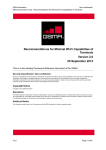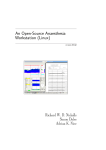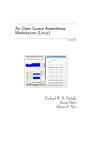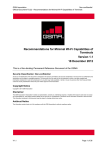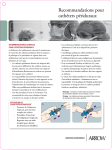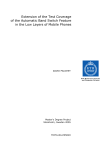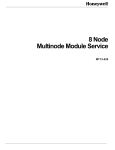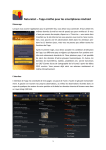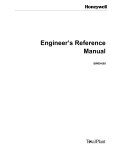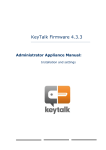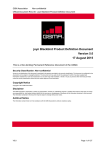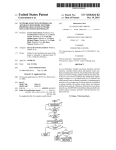Download "user manual"
Transcript
GSM Association Non-confidential Official Document TS.22 - Recommendations for Minimum Wi-Fi ® Capabilities of Terminals Recommendations for Minimum Wi-Fi ® Capabilities of Terminals Version 4.0 22 September 2015 This is a Non-binding Permanent Reference Document of the GSMA Security Classification: Non-confidential Access to and distribution of this document is restricted to the persons permitted by the security classification. This document is confidential to the Association and is subject to copyright protection. This document is to be used only for the purposes for which it has been supplied and information contained in it must not be disclosed or in any other way made available, in whole or in part, to persons other than those permitted under the security classification without the prior written approval of the Association. Copyright Notice Copyright © 2015 GSM Association Disclaimer The GSM Association (“Association”) makes no representation, warranty or undertaking (express or implied) with respect to and does not accept any responsibility for, and hereby disclaims liability for the accuracy or completeness or timeliness of the information contained in this document. The information contained in this document may be subject to change without prior notice. Antitrust Notice The information contain herein is in full compliance with the GSM Association’s antitrust compliance policy. V4.0 Page 1 of 38 GSM Association Non-confidential Official Document TS.22 - Recommendations for Minimum Wi-Fi ® Capabilities of Terminals Table of Contents 1 2 3 4 5 6 7 8 9 Introduction 1.1 Purpose 1.2 Scope and Objective 1.3 Definition of Terms 1.4 Reference Documents Alignment with Wi-Fi Alliance Certification Programmes 2.1 Wi-Fi Alliance Certification Programmes 2.2 Wi-Fi CERTIFIED Wi-Fi Direct ® 2.3 Dual-band Support Bands 2.4 3GPP Release 12 specifications WLAN Policy Provisioning 4 4 4 4 6 9 9 11 12 12 12 3.1 Operator Policy Provisioning 3.1.1 3GPP ANDSF Policy Provisioning 3.1.2 3GPP RAN assisted WLAN interworking 3.1.3 3GPP Operator policy coexistence 3.2 User/Manual Provisioning Connection Management 12 13 13 13 14 15 4.1 Connection Management Client 4.2 Network Discovery 4.3 WLAN Radio Link and Connection Quality 4.4 Intermittent WLAN Connectivity 4.5 WLAN Access Network Selection 4.5.1 3GPP WLAN Access Network Selection 4.6 Managing Radio Connections based on Multiple Access Technologies 4.7 Traffic management across RATs 4.8 IP Version Support Security 15 16 16 18 18 19 20 21 23 24 5.1 Authentication Protocols 5.1.1 EAP-SIM/EAP-AKA/EAP-AKA’ and 3GPP Service Provider selection 5.2 WLAN Over the Air Security Wi-Fi Protected Setup 24 24 26 26 User Interface 7.1 WLAN On/Off Function Accessibility 7.2 Status Information 7.3 Authentication Architecture Overload Data Prevention 7.4 Access to U/SIM When 3GPP Radio is in Flight Mode Power Management 8.1 Power Save Mechanisms 8.2 Idle Power Management Parental Control 9.1 Support of Access to EPC via Untrusted WLAN on Terminals 9.2 Support of Access to EPC via Trusted WLAN on Terminals 27 27 27 27 28 29 29 29 30 31 32 V4.0 Page 2 of 38 GSM Association Non-confidential Official Document TS.22 - Recommendations for Minimum Wi-Fi ® Capabilities of Terminals 9.3 Support of PDN Connections 9.3.1 Multiple PDN connections 9.4 Support of IMS Profile for Voice, Video and SMS over Wi-Fi Annex A Future Work Handover between 3GPP and WLAN access networks WLAN Access Network Management and Troubleshooting Updates driven in related standardisation bodies such as 3GPP, OMA, WiA.1 Fi Alliance etc. A.2 Annex B Document Management A.3 Document History Other Information V4.0 32 32 33 34 34 34 36 37 37 38 Page 3 of 38 GSM Association Non-confidential Official Document TS.22 - Recommendations for Minimum Wi-Fi ® Capabilities of Terminals Introduction 1.1 1 Purpose Wi-Fi has been steadily increasing as a standard feature for radio access in a device. However, a device has varying degrees of Wireless Local Area Network (WLAN) support which poses a number of risks in the market such as different implementations of WLAN confusing end-users, which results in a reluctance to use it. The different WLAN implementations and requirements also cause interoperability issues and create fragmentation that impacts its use in the market. The GSMA TSG (Terminal Steering Group) has established a dedicated work item for operators and vendors to share existing WLAN experiences from operators, to assess relevant industry activities, to gather input from other organisations, and to create a PRD (Permanent Reference Document). The outcome shall help drive and standardise WLAN implementation of MNOs and OEMs and facilitate support of WLAN functionality and usability for users of WLAN services on operator networks. Note that the Annexes containing the Use Cases from which the original requirements for this PRD were derived have been deprecated in V3.0 of this document, as they became obsolete as the requirements were modified and expanded with the changing industry. 1.2 Scope and Objective The aim of this document is to consolidate minimum device requirements (or references where these have been published already by other groups) for a WLAN enabled device. It is the intent of this PRD to facilitate alignment of operator WLAN requirements and to enhance the WLAN functionality and usability for users of WLAN services on operator networks. This PRD does not exclude the possibility for support of additional WLAN capabilities not mentioned in this document. 1.3 Definition of Terms Term Description 3GPP Third Generation Partnership Project ANDSF Access Network Discovery and Selection Function ANQP Access Network Query Protocol AP Access Point API Application Programming Interface APN Access Point Name BSS Basic Service Set EAP Extensible Authentication Protocol EPC 3GPP Enhanced Packet Core ePDG Evolved Packet Data Gateway EPS Evolved Packet System V4.0 Page 4 of 38 GSM Association Non-confidential Official Document TS.22 - Recommendations for Minimum Wi-Fi ® Capabilities of Terminals Term Description ESS Extended Service Set GSM Global System for Mobile Communications GTP GPRS Tunnelling Protocol Hotspot 2.0 Wi-Fi Alliance programme that certifies a Hotspot 2.0 device HPLMN Home Public Land Mobile Network IE Information Element IEEE Institute of Electrical and Electronics Engineers IETF Internet Engineering Task Force IMS IP Multimedia Subsystem LAN Local Area Network LTE Long Term Evolution MAC Media Access Control MAPCON Multi Access PDN Connectivity MNO Mobile Network (i.e. 3GPP PLMN) Operator MNS Mobile Network (i.e. 3GPP PLMN) Service NAI Network Access Identifier NFC Near Field Communications OMA Open Mobile Alliance OMA DM OMA Data Management OTA Over the air PasspointTM Wi-Fi CERTIFIED Passpoint™ P-CSCF Proxy Call Session Control Function PDN Packet Data Network PDN GW Packet Data Network GateWay PIN Personal Identification Number PLMN Public Land Mobile Network PMF Protected Management Frame OEM Original Equipment Manufacturer QoS Quality of Service PRD Permanent Reference Document RAT Radio Access Technology RSSI Receive Signal Strength Indication SaMOG S2a Mobility Based on GTP (GPRS Tunnelling Protocol) SIM Subscriber Identity Module SIP Session Initiation Protocol SMS Short Message Service SSID Service Set Identifier SWw The name of a 3GPP architecture reference point V4.0 Page 5 of 38 GSM Association Non-confidential Official Document TS.22 - Recommendations for Minimum Wi-Fi ® Capabilities of Terminals Term Description TWAG Trusted Wireless Access Gateway UI User Interface UICC Universal Integrated Circuit card UMTS Universal Mobile Telecommunications System USIM Universal SIM VPLMN Visited Public Land Mobile Network WEP Wired Equivalent Privacy WFA Wi-Fi Alliance Wi-Fi WLAN products which are usually Wi-Fi Alliance certified WLAN Wireless Local Area Network WMM Wireless Multi-Media WPA2 Wi-Fi Protected Access Version 2 XCAP XML Configuration Access Protocol (XCAP) XML Extensible Markup Language 1.4 Reference Documents Document Number Passpoint Wi-Fi Alliance Certification Programs Wi-Fi Direct Title Wi-Fi Alliance Hotspot 2.0 Technical Specification, v1.00 Source: https://www.wi-fi.org/hotspot-20-technical-specification-v100 Wi-Fi Alliance Certification Programs See: http://www.wi-fi.org/certification/programs Wi-Fi Alliance, Wi-Fi CERTIFIED Wi-Fi Direct ® Technical Specification Source: https://www.wi-fi.org Open CM API Requirements Document Release 1.0 OpenCMAPI 3GPP TS 23.060 Source: http://www.openmobilealliance.org/Technical/release_program/docs/CopyrightClic k.aspx?pck=OpenCMAPI&file=V1_0-20110712-C/OMA-RD-OpenCMAPI-V1_020110712-C.pdf 3rd Generation Partnership Project; Technical Specification Group Services and System Aspects; General Packet Radio Service (GPRS); Service description; Stage 2 Latest version of: http://www.3gpp.org/ftp/specs/archive/23_series/23.060/ 3GPP TS 23.401 3rd Generation Partnership Project; Technical Specification Group Services and System Aspects; General Packet Radio Service (GPRS) enhancements for Evolved Universal Terrestrial Radio Access Network (E-UTRAN) access (Release 12) Latest version of: http://www.3gpp.org/ftp/specs/archive/23_series/23.401/ 3GPP TS 23.402 V4.0 3rd Generation Partnership Project; Technical Specification Group Core Network; Architecture enhancements for non-3GPP accesses Page 6 of 38 GSM Association Non-confidential Official Document TS.22 - Recommendations for Minimum Wi-Fi ® Capabilities of Terminals Document Number Title Latest version of: http://www.3gpp.org/ftp/specs/archive/23_series/23.402/ 3GPP TS 24.234 3rd Generation Partnership Project; Technical Specification Group Core Network; 3GPP System to WLAN Interworking; UE to Network Protocols Latest version of: http://www.3gpp.org/ftp/specs/archive/24_series/24.234/ 3GPP TS 24.302 3rd Generation Partnership Project; Technical Specification Group Core Network and Terminals; Access to the 3GPP Evolved Packet Core (EPC) via non-3GPP access networks; Stage 3 Latest version of: http://www.3gpp.org/ftp/specs/archive/24_series/24.302/ 3GPP TS 24.312 3rd Generation Partnership Project; Technical Specification Group Core Network and Terminals, Access Network Discovery and Selection Function (ANDSF) Management Object (MO) Latest version of: http://www.3gpp.org/ftp/specs/archive/24_series/24.312/ 3GPP TS 31.102 3rd Generation Partnership Project; Technical Specification Group Core Network and Terminals; Characteristics of the Universal Subscriber Identity Module (USIM) application. Latest version of: http://www.3gpp.org/ftp/specs/archive/31_series/31.102/ 3GPP TS 31.115 3 Generation Partnership Project; Technical Specification Group Core Network and Terminals; Secured packet structure for (Universal) Subscriber Identity Module (U)SIM Toolkit applications. Latest version of: http://www.3gpp.org/ftp/specs/archive/31_series/31.115/ 3GPP TS 31.116 3 Generation Partnership Project; Technical Specification Group Core Network and Terminals; Remote APDU Structure for (U)SIM Toolkit applications. Latest version of: http://www.3gpp.org/ftp/specs/archive/31_series/31.116/ rd rd 3GPP TS 33.234 3rd Generation Partnership Project; Technical Specification Group Services and System Aspects;3G Security; Wireless Local Area Network (WLAN) interworking security Latest version of: http://www.3gpp.org/ftp/specs/archive/33_series/33.234/ rd 3GPP TS 33.402 3 Generation Partnership Project; Technical Specification Group Services and System Aspects;3GPP System Architecture Evolution (SAE);Security aspects of non-3GPP accesses Latest version of: http://www.3gpp.org/ftp/specs/archive/33_series/33.402/ 3GPP TS 36.304 3rd Generation Partnership Project; Technical Specification Group Radio Access Network; Evolved Universal Terrestrial Radio Access (E-UTRA); User Equipment (device) procedures in idle mode Latest version of: http://www.3gpp.org/ftp/specs/archive/36_series/36.304/ 3GPP TS 25.304 3rd Generation Partnership Project; Technical Specification Group Radio Access Network; User Equipment (device) procedures in idle mode and procedures for cell reselection in connected mode Latest version of: http://www.3gpp.org/ftp/specs/archive/36_series/25.304/ 3GPP TS 25.331 3rd Generation Partnership Project; Technical Specification Group Radio Access Network; Radio Resource Control (RRC); Protocol specification Latest version of: http://www.3gpp.org/ftp/specs/archive/36_series/25.331/ 3GPP TS 36.331 3rd Generation Partnership Project; Technical Specification Group Radio Access Network; Radio Resource Control (RRC); Protocol specification Latest version of: http://www.3gpp.org/ftp/specs/archive/36_series/36.331/ V4.0 Page 7 of 38 GSM Association Non-confidential Official Document TS.22 - Recommendations for Minimum Wi-Fi ® Capabilities of Terminals Document Number IEEE 802.11-2012 IEEE 802.11 HT IEEE 802.11 VHT Title IEEE 802.11-2012, Part 11: Wireless LAN Medium Access Control (MAC) and Physical Layer (PHY) Specifications. Source: https://standards.ieee.org/findstds/standard/802.11-2012.html Enhancements for High Throughput (HT) were first defined in Amendment 802.11n™, and have since been incorporated into 802.11-2012 [IEEE 802.112012] in section 20. Enhancements for Very High Throughput (VHT) for Operation in Bands below 6 GHz, is existing Amendment 802.11ac™ to 802.11-2012 [IEEE 802.11-2012] IEEE 802.11 Legacy PHY IEEE 802.11 legacy Physical Layer (PHY) Amendments 802.11a™, 802.11b™, and 802,11g™ were first defined as amendments to 802.11-1999, and have since been incorporated into 802.11-2007 and beyond. IEEE 802.11 Fast BSS Transition Fast Basic Service Set (BSS) Transition was first defined in Amendment 802.11r™, and has since been incorporated into 802.11-2012 [IEEE 802.11-2012] in section 12. IEEE 802.11 RRM Radio Resource Measurement (RRM) for Wireless LANs was first defined in Amendment 802.11k™, and has since been incorporated into 802.11-2012 [IEEE 802.11-2012] in section 10. RFC 1981 RFC 2460 RFC 3736 RFC 3748 RFC 4186 Path MTU Discovery for IP version Source: http://www.ietf.org/rfc/rfc1981.txt Internet Protocol, Version 6 (IPv6) Source: http://www.ietf.org/rfc/rfc2460.txt Stateless Dynamic Host Configuration Protocol (DHCP) Service for IPv6 Source: http://www.ietf.org/rfc/rfc3736.txt Extensible Authentication Protocol (EAP) Source: http://www.ietf.org/rfc/rfc3748.txt Extensible Authentication Protocol Method for Global System for Mobile Communications (GSM) Subscriber Identity Modules (EAP-SIM) Source: http://www.ietf.org/rfc/rfc4188.txt RFC 4187 Extensible Authentication Protocol Method for 3rd Generation Authentication and Key Agreement (EAP-AKA) Source: http://www.ietf.org/rfc/rfc4187.txt RFC 4436 RFC 4443 Detecting Network Attachment in IPv4 (DNAv4) Source: http://www.ietf.org/rfc/rfc4436.txt Internet Control Message Protocol (ICMPv6) for the Internet Protocol Version 6 (IPv6) Source: http://www.ietf.org/rfc/rfc4443.txt RFC 4861 RFC 4862 RFC 4941 RFC 5175 V4.0 Neighbour Discovery for IP version 6 (IPv6) Source: http://www.ietf.org/rfc/rfc4861.txt IPv6 Stateless Address Autoconfiguration Source: http://www.ietf.org/rfc/rfc4862.txt Privacy Extensions for Stateless Address Autoconfiguration in IPv6 Source: http://www.ietf.org/rfc/rfc4941.txt IPv6 Router Advertisement Flags Option Page 8 of 38 GSM Association Non-confidential Official Document TS.22 - Recommendations for Minimum Wi-Fi ® Capabilities of Terminals Document Number Title Source: http://www.ietf.org/rfc/rfc5175.txt RFC 5247 Extensible Authentication Protocol (EAP) Key Management Framework Source: http://www.ietf.org/rfc/rfc5247.txt Improved Extensible Authentication Protocol Method for RFC 5448 3rd Generation Authentication and Key Agreement (EAP-AKA') Source: http://www.ietf.org/rfc/rfc5448.txt RFC 6106 IPv6 Router Advertisement Options for DNS Configuration Source: http://www.ietf.org/rfc/rfc6106.txt Device Management Bootstrap OMA Device Management Bootstrap Source: http://technical.openmobilealliance.org/Technical/release_program/docs/copyrightc lick.aspx?pck=DM&file=V1_2_1-20080617-A/OMA-TS-DM_Bootstrap-V1_2_120080617-A.pdf Alignment with Wi-Fi Alliance Certification Programmes 2 It is essential for a device with WLAN capabilities to support Wi-Fi Alliance certifications to ensure that devices and network elements from multiple vendors are interoperable. 2.1 Wi-Fi Alliance Certification Programmes A device is expected to support the certification requirements listed in this subsection in order to achieve the following objectives: Interoperability with public WLANs (hotspots) including scalability of authentication systems, Interoperability with consumer/residential networks, Interoperability with enterprise networks. IEEE 802.11n™ [IEEE 802.11 HT], which operates in the 2.4 and 5 GHz bands, provides high performance over legacy specifications 802.11a™, 11b™ and 11g™ [IEEE 802.11 Legacy PHY]. IEEE 802.11ac™ [IEEE 802.11 VHT], the very latest version of Wi-Fi in 5 GHz, pushes Wi-Fi performance past the gigabit-per-second data rate for network capacity. Since the radio channel is shared by an AP and a device, increasing performance results in improved channel capacity for a device. A device should be IEEE 802.11n or 802.11ac capable. For a device which is IEEE 802.11n capable, the Wi-Fi Alliance baseline certification requires the device to be Wi-Fi CERTIFIED n™. For a device which is IEEE 802.11ac capable, the Wi-Fi Alliance baseline certification requires the device to be Wi-Fi CERTIFIED ac™. In addition, both certifications include WPA2™ (Wi-Fi Protected Access 2) and Wi-Fi Multimedia (WMM) testing. WPA2 testing and certification provides WLAN access network security - offering government-grade security mechanisms for personal, enterprise and hotspot deployments. V4.0 Page 9 of 38 GSM Association Non-confidential Official Document TS.22 - Recommendations for Minimum Wi-Fi ® Capabilities of Terminals The WMM certification provides support for multimedia content over WLAN access networks enabling WLAN access networks to prioritize traffic generated by different applications using Quality of Service (QoS) mechanisms. WMM® certifies products which implement technology defined in the WMM® Technical Specification. For a device which is not IEEE 802.11n or 802.11ac capable, the Wi-Fi Alliance baseline consists of separate certifications: the IEEE 802.11 certification for radio types of IEEE 802.11a, IEEE 802.11b, IEEE 802.11g with WPA2 and the WMM® certification. A device shall be Wi-Fi CERTIFIED WPA2 with Protected Management Frames (PMF), which provides a WPA2-level of protection for unicast and multicast management action frames. Protection of management frames prevents attacks in which a wireless attacker forges frames (mimicking an AP) and transmits them to a victim device. Without PMF, this attack could cause the victim device, for example, to disassociate from a WLAN access network, tear down a QoS flow, etc. A device shall be Wi-Fi CERTIFIED Passpoint™ [Passpoint]. Passpoint certifies that products implement the technology defined in the Wi-Fi Alliance Hotspot 2.0 Release 1 Technical Specification. This technology enables advertisement of roaming relationships between the Passpoint operators, similar to those mechanisms used today for 3GPP access, allowing the device to automatically discover and connect to WLANs. It also automatically configures WPA2-Enterprise level security (using EAP-SIM, EAP-AKA or EAP-AKA’) without user intervention. Passpoint certification requires Wi-Fi Alliance baseline certification as a pre-requisite. A device should support Fast BSS Transition [IEEE 802.11 Fast BSS Transition], in order to significantly reduce the load on a Mobile Network Service Providers (MNSP)'s HLR/HSS. Note that a device using WPA2-Enterprise with EAP-SIM, EAP-AKA or EAP-AKA' authenticates with its home AAA server every time the device transitions from one AP to another within the same WLAN access network. A device using Fast BSS Transition authenticates to its home AAA server only on the first authentication with the WLAN access network; all subsequent authentications are handled locally. Example deployments where the use of Fast BSS Transition can dramatically reduce the load on the MNSP's HLR/HSS include high density environments (e.g., sporting venue, train station) or Community WLAN access networks (e.g., a user walking down a street would connect to AP after AP in sequence). A device should also support IEEE 802.11 Radio Resource Measurement (RRM) [IEEE 802.11 RRM]. RRM features provide network operators greater capability to manage WLAN to WLAN interference, improve roaming, etc. The Wi-Fi Alliance has included certification of Fast BSS Transition and RRM capabilities within the Voice-Enterprise certification. Although portions of this certification, which include performance testing using simulated VoIP streams are not required by this PRD, VoiceEnterprise is currently the only certification option for Fast BSS Transition and RRM. A device should be Wi-Fi CERTIFIED WMM-Power Save™. This certification program provides power savings for delivering multimedia content over WLAN access networks – it helps conserve battery life while using voice and multimedia applications by managing the V4.0 Page 10 of 38 GSM Association Non-confidential Official Document TS.22 - Recommendations for Minimum Wi-Fi ® Capabilities of Terminals time the device spends in sleep mode. Testing has shown 37 - 73% power savings versus legacy power save mechanisms. A device shall be Wi-Fi CERTIFIED Wi-Fi Protected Setup™. This certification program facilitates easy set-up of security features using a Personal Identification Number (PIN) or other defined methods within the device. Wi-Fi Protected Setup certifies products which implement technology defined in the Wi-Fi Simple Configuration Technical Specification. Req ID Requirement TSG22_R2_WFA_01 A device SHALL be IEEE 802.11n or 802.11ac capable. TSG22_R2_WFA_02 A device SHALL be Wi-Fi CERTIFIED WPA2 with Protected Management Frames. TSG22_R2_WFA_03 A device SHALL be Wi-Fi CERTIFIED Passpoint. TSG22_R2_WFA_04 A device SHOULD be Wi-Fi CERTIFIED Voice-Enterprise. TSG22_R2_WFA_05 A device SHOULD be Wi-Fi CERTIFIED WMM-Power Save. TSG22_R2_WFA_06 A device SHALL be Wi-Fi CERTIFIED Wi-Fi Protected Setup. The Wi-Fi Alliance certification programs are located at http://www.wifi.org/certification/programs 2.2 Wi-Fi CERTIFIED Wi-Fi Direct ® Wi-Fi CERTIFIED Wi-Fi Direct [Wi-Fi Direct] is a certification mark for a WLAN client device that connects directly without use of an AP, to enable applications such as printing, content sharing, and display. Wi-Fi Direct certifies products which implement technology defined in the Wi-Fi Alliance Peer-to-Peer Technical Specification (see www.wi-fi.org/wi-fi_direct.php) Mobile phones, cameras, printers, PCs, and gaming devices can connect to each other directly to transfer content and share applications quickly and easily. A device can make a one-to-one connection, or a group of several devices can connect simultaneously. Connecting a Wi-Fi Direct device is easy and simple, in many cases only requiring the push of a button. Wi-Fi Direct certification requires a device to implement WPA2-Personal level security. Some Wi-Fi Direct devices maintain an infrastructure connection concurrently with a Wi-Fi Direct connection, and it is possible for the device to provide cross-connect capabilities which allows a Wi-Fi Direct peer to access a network through another associated peer. As infrastructure Wi-Fi deployments require the more stringent WPA2-Enterprise level security this could compromise the infrastructure network, allowing the device which is not authenticated with the network to have network access. To avoid this potential security breach, a Wi-Fi Direct capable device needs to provide the capability to disable infrastructure connections when connecting over Wi-Fi Direct. Note: this section may be modified at a later date if clarifying technical information on Wi-Fi Direct™ is received from the Wi-Fi Alliance. V4.0 Page 11 of 38 GSM Association Non-confidential Official Document TS.22 - Recommendations for Minimum Wi-Fi ® Capabilities of Terminals Req ID Requirement TSG22_R2_WFA_07 A device SHOULD support the Wi-Fi Direct certification program. TSG22_R3_WFA_08 A device which supports Wi-Fi Direct SHOULD provide the user with the ability to prevent cross connect between a Wi-Fi Direct connection and an access network connection. 2.3 Dual-band Support Bands The 2.4GHz band is widely deployed and in many areas can become congested due to both the number of APs in an area as well as the number of users trying to receive a service in that area. The 5GHz band is now becoming more widely deployed by both operators and in home networks. Consequently, a device should support the use of the 5GHz band. It is advantageous for a device to support dual-band operations, working in either the 2.4 GHz band or the 5 GHz band. This allows a device to use all available APs (regardless of band), and allows dual-band APs to balance the load of the device, across bands. Req ID Requirement TSG22_R2_USE_02 A device SHOULD be able to operate in the 5GHz band. TSG22_R3_USE_03 A device SHOULD support dual-band operation in the 2.4 GHz and 5 GHz bands. 2.4 3GPP Release 12 specifications Within this document the terms: pre-release 12, release 12 and post-release 12 devices refer to devices, which meet 3GPP specifications. 3 WLAN Policy Provisioning 3.1 Operator Policy Provisioning Expanded service of operators through service agreements and partnerships can significantly increase the coverage and list of network identifiers (e.g. SSID) within a user’s subscription. An update mechanism shall be in place to broker the inclusion of new parameters and data (e.g. SSIDs) within the user’s subscription, together with the exclusion or removal of irrelevant ones.OMA DM can provide a means to configure a device, either through the 3GPP network or directly over the WLAN access network or some operators may pre-configure a device to select operator controlled APs. In order for the OMA DM client in the device to be able to access the OMA DM server, it is necessary to bootstrap the device with at least the address of the OMA DM server (e.g. URL of the OMA DM server) and the credentials (e.g. username and password) for the OMA DM client to authenticate to the OMA DM Server. OMA DM Bootstrap specification v1.2 [OMA Device Management Bootstrap] provides three options for configuring the bootstrap information in the device: 1. At the factory, during the device personalization for instance; V4.0 Page 12 of 38 GSM Association Non-confidential Official Document TS.22 - Recommendations for Minimum Wi-Fi ® Capabilities of Terminals 2. Via an OMA Push message from the OMA DM server; or, 3. From the information stored in the UICC (in the EF Bootstrap file). OMA DM provides a means to provision a device at the initialisation phase from the UICC (see [OMA Device Management Bootstrap]). When bootstrap information is stored in the UICC bootstrap file, according to OMA Device Management Bootstrap specification, a device is required to use the information from the EF Bootstrap file, as the device is a GSM device. 3.1.1 3GPP ANDSF Policy Provisioning For ANDSF operation, the ANDSF policies are provided to the device as defined in TS 23.402 [3GPP TS 23.402], TS 24.302 [3GPP TS 24.302] and TS 24.312 [3GPP TS 24.312]. 3.1.2 3GPP RAN assisted WLAN interworking In RAN assisted WLAN interworking for E-UTRAN the RAN assistance information defined in TS 36.304 [3GPP TS 36.304] clause 5.6 and TS 24.312 [3GPP TS 24.312] clause 5.7.21B34 (OPI) are provided to the device by the E-UTRAN as specified in TS 36.331 clause 5.6.12. For UTRAN the RAN assistance information defined in TS 25.304 [3GPP TS 25.304] clause 5.10 and TS 24.312 [3GPP TS 24.312] clause 5.7.21B34 (OPI) are provided to the device by the UTRAN as specified in TS 25.331 [3GPP TS 25.331]. RAN rules may be used to support the selection of WLAN for performing the handover of one or more “off loadable” PDN connections. The RAN rules have been defined in TS 36.304 [3GPP TS 36.304] clause 5.6.2. The use of the RAN rules on the device has been defined in TS 23.402 [3GPP TS 23.402] and TS24.302 [3GPP TS 24.302]. For traffic steering via RAN rules, the MME may provide information to the device indicating which PDN Connection can be offloaded to WLAN as specified in TS 23.401 [3GPP TS 23.401] clause 4.3.23. As specified in the same clause, traffic steering decisions using RAN rules are not applicable to non-seamless WLAN offload. 3.1.3 3GPP Operator policy coexistence The WLAN access selection and the traffic routing behaviour of a device using SIM credentials within a single PLMN shall be controlled either by the ANDSF rules or by the RAN rules not by both. The device can be provisioned with both policies, and the device shall select the policy to be used as defined in TS 23.402 [3GPP TS 23.402] clause 4.8.6.4 and TS 24.302 [3GPP TS 24.302] clause 6.10. 3GPP Home Operator and/or Visited Operator policies may be used to assist the device in selecting a WLAN access point and in steering traffic between 3GPP and WLAN accesses. For WLAN selection, according to TS 24.302 [3GPP TS 24.302] clause 5.1.3.2.3, the following applies: V4.0 When the network uses RAN rules with a release 12 or post-release 12 device as defined in TS 23.401 [3GPP TS 23.401] clause 4.3.23 and TS 23.060 [3GPP TS 23.060] clause 5.3.21, a list of WLAN identities (e.g. SSID, HESSID) as part of RAN Assistance parameters may be sent by the 3GPP RAN to the device. Page 13 of 38 GSM Association Non-confidential Official Document TS.22 - Recommendations for Minimum Wi-Fi ® Capabilities of Terminals When the network uses ANDSF rules with a release 12 or post-release 12 device as defined in TS 23.402 [3GPP TS 23.402] clause 4.8.2.1.6, the Home and Visited Operator WLAN Selection Policies (WLANSP) that include a list of Preferred Roaming Partners defined in WFA HS 2.0 [Passpoint] and identified by their PLMN identifiers or NAI Realms as specified in IEEE 802.11-2012 [IEEE 802.11-2012] and, for authentication purposes, a list of Preferred SSID may be sent to the device via OMA DM. A device may be pre-provisioned by necessary subscription information (e.g. SSIDs and accompanying security keys) for connection to operator-owned WLAN access networks. 3GPP has, in addition, defined a set of I-WLAN parameters provisioned into the USIM [3GPP TS 31.102] to be used by the device. In addition, 3GPP has also defined OTA (Over The Air) mechanisms in order to update the USIM parameters including the WLAN parameters [3GPP TS 31.115] [3GPP TS 31.116]. However, as stated in TS 24.234 [3GPP TS 24.234] “WLAN Network Selection supersedes I-WLAN for device WLAN selection as specified in 3GPP TS 24.302 from Rel-12 onwards”. This means that WLAN selection and associated PLMN selection are non-backward compatible between Release 12 and preRelease 12. This also means that Release 12 features are not supported by devices that use I-WLAN feature for WLAN selection and associated PLMN selection. Req ID Requirement TSG22_R2_CM_01 A pre-Release 12 device SHALL support provisioning of WLAN parameters (e.g. network identifiers) using the USIM as specified in 3GPP TS 31.102 [3GPP TS 31.102] and 3GPP TS 24.234 [3GPP TS24.234]. However, as stated in TS 24.234 [3GPP TS 24.234] “WLAN Network Selection supersedes I-WLAN for device WLAN selection as specified in 3GPP TS 24.302 from Rel-12 onwards”, no such requirement exists for Release 12 and post-Release 12 devices TSG22_R3_CM_49 A device that supports OMA DM Management Objects SHOULD support mandatory features of OMA DM Bootstrap as defined in [OMA Device Management Bootstrap] and the conditional features of OMA DM Bootstrap relevant to a GSMA device described in this document TSG22_R4_CM_50 A Release 12 or post-release 12 device SHOULD support provisioning of WLAN parameters (e.g. network identifiers) using the USIM via 3GPP ANDSF as specified in TS 23.402 [3GPP TS 23.402] , TS 24.302 [3GPP TS 24.302] clauses 5.1.3.2.3, 6.8 and 6.10 and TS 24.312 [3GPP TS 24.312]. TSG22_R4_CM_51 A Release 12 or post-release 12 device SHOULD support provisioning of WLAN parameters (e.g. network identifiers) using the USIM via 3GPP RAN Rules provisioned by E-UTRAN/UTRAN as specified in TS 23.401 [3GPP TS 23.401], TS 23.060 [3GPP TS 23.060], TS 36.304 [3GPP TS 36.304] clause 5.6, TS 36.331 [3GPP TS 36.331] clause 5.6.12, TS 25.304 [3GPP TS 25.304] clause 5.10, TS 25.331 [3GPP TS 25.331]. 3.2 User/Manual Provisioning In most devices today, manual provisioning is already available. This will often be the case for hotspots that the operator does not own and in home network setups. The facility often V4.0 Page 14 of 38 GSM Association Non-confidential Official Document TS.22 - Recommendations for Minimum Wi-Fi ® Capabilities of Terminals exists to store profiles so that every time a device is in range of an existing WLAN hotspot setup, the connection is automatic. Req ID Requirement TSG22_R2_CM_03 A device SHALL allow the user to provision network identifiers (e.g. SSID), credentials and priorities. TSG22_R2_CM_04 If the user manually provisions configurations in a device, they SHALL be stored in the USIM if the corresponding files are available, otherwise in the device. Connection Management 4 4.1 Connection Management Client Connection management clients interface between several layers providing an intuitive means of managing connectivity, preferences and networks. The implementation will vary per operating system and manufacturer but most of the work of the client should be to use API calls rather than issuing low level calls itself. This will make the build of clients easier and more uniform throughout devices and operating systems. Connection management clients are in charge of managing all connections. In the context of this document, the connection management client, or application manages different WLAN access network connections based on a device status, connection conditions, operator policies and user profiles associated with these connections. The following are examples of connection management APIs that a device could implement to improve WLAN management: V4.0 Turn on and turn off the WLAN (including support of flight mode, where flight mode means that a device has the functionality to turn off wireless modules in case the transmitting and receiving of the wireless signals impacts the safety of aircraft flight.) Query if WLAN functionality is on or off Interact with the connection manager to connect to and disconnect from APs Use the operator predefined list of preferred network identifiers (e.g. SSID) Add, delete, modify and manage WLAN profiles, including information such as network identifiers (e.g. SSID), secured or open network, discover security methods and authentication credentials. Access to detailed information per network identifier, such as the WLAN signal strength per network identifier (e.g. SSID – active or inactive), WLAN channel physical rate, backhaul capability (if available), security methods and authentication credentials used, known or unknown network) Access to the list of available network identifiers (e.g. SSID) Support automatic & manual connection modes Force the association to a specific network identifier (e.g. SSID), visible or not. Listen to the WLAN events such as new available network, loss of network, successful association on a specific network identifier (e.g. SSID). Page 15 of 38 GSM Association Non-confidential Official Document TS.22 - Recommendations for Minimum Wi-Fi ® Capabilities of Terminals Access to information on an active session using a specific network identifier (e.g. a SSID) such as IP address, Mac Address, Subnet Address Modify information on WLAN connection such as IP address, Subnet Address Req ID Requirement TSG22_R2_CM_05 A device SHALL have at least one pre-installed connection management client. TSG22_R2_CM_06 A device SHOULD have programming interfaces/APIs to control and/or manage WLAN connections. TSG22_R2_CM_07 VOID TSG22_R2_CM_08 A device SHOULD offer an API compliant with the OMA [OpenCMAPI] for WLAN management. TSG22_R3_CM_46 The connection manager SHALL provide an API to turn on and turn off the WLAN (including support of flight mode, where flight mode means that a device SHALL have the functionality to turn off wireless modules 4.2 Network Discovery Constant scanning for detection of a hotspot may place a heavy toll on the battery life of a Smartphone. A device should implement periodic scanning algorithms that preserve battery life. The scanning algorithm should take into account Passpoint network discovery. Req ID Requirement TSG22_R2_CM_10 A device SHALL be able to provide detailed information per network identifier discovered (such as signal strength, security methods, type of authentication credentials used, known or unknown network) to the user and/or application. TSG22_R2_CM_11 A device SHALL support a WLAN access network discovery mechanism. TSG22_R2_CM_12 A device SHOULD be able to listen & report events to an upper layer (e.g. UI) such as new available network, loss of network. TSG22_R3_CM_47 A device’s WLAN access network discovery mechanism SHALL preserve battery life. 4.3 WLAN Radio Link and Connection Quality On most devices, once a WLAN is detected, a device defaults to use the WLAN connection to provide data connectivity to applications. Unfortunately, being connected to the AP does not necessarily mean that there is data connectivity to the Internet or that the connectivity will provide adequate user experience. For the purpose of WLAN access network selection (See Section 4.5) and management of multiple radio connections on the device (See Section 4.6), consideration of the WLAN radio link and connection quality are important to avoid poor user experience. A device should consider over the air utilization of the WLAN AP (e.g. WLAN channel utilization which may be advertised in beacons), backhaul status of an AP (e.g. Wi-Fi Alliance Hotspot 2.0 WAN metrics information which may be obtained via an ANQP query), WLAN signal strength (e.g. WLAN Beacon RSSI as specified in TS 36.304 [3GPP TS V4.0 Page 16 of 38 GSM Association Non-confidential Official Document TS.22 - Recommendations for Minimum Wi-Fi ® Capabilities of Terminals 36.304] clause 5.6.2 for ANDSF and RAN rules) to avoid connection to an AP with no connectivity or which is not suitable to provide basic connectivity. The criteria defining a suitable AP may be default criteria in the device and should include at least a minimum signal strength level (e.g. WLAN Beacon RSSI), a maximum channel utilisation value for air interface loading (as defined by WLAN channel utilization in IEEE 802.11) and a minimum backhaul bandwidth threshold. The minimum backhaul bandwidth may be derived from information received in Wi-Fi Alliance Hotspot 2.0 WAN metrics Information element. These criteria may also be preconfigured by the operator in the device or provisioned as part of operator policy. If criteria (e.g. as defined by priorities and/or thresholds) are pre-configured or provisioned by the operator, they should be considered with higher priority than default values. The device may in addition have proprietary schemes to consider additional parameters in order to determine whether the AP is adequate or not. Once a device is connected on a WLAN access network it should be able to monitor whether the AP can continue to provide adequate throughput (as defined by a default minimum throughput threshold criterion, preconfigured operator policy on minimum throughput threshold or operator provisioned policy containing a minimum throughput threshold). If the minimum throughput threshold cannot be satisfied, the device should be able to switch its connection to another AP or to a 3GPP network. Req ID Requirement TSG22_R2_CM_13 A device SHALL have the capability to monitor the WLAN signal strength (e.g. WLAN Beacon RSSI). TSG22_R2_CM_14 A device SHOULD consider the following parameters, when available, in selection of a AP, based on default priorities and/or thresholds for those parameters specified by the manufacturer: - WLAN signal strength (WLAN Beacon RSSI) - IEEE 802.11 Channel Utilization IE - Wi-Fi Alliance Hotspot 2.0 WAN Metrics IE TSG22_R2_CM_15 A device SHOULD be able to monitor the data throughput level on the serving AP. TSG22_R2_CM_16 A device SHOULD have the ability to switch their network connection away from a serving AP which is not providing adequate throughput (as defined by a minimum throughput threshold criterion, which is default, preconfigured by operator policy, or provisioned by operator policy) to another AP, or to a 3GPP network. TSG22_R2_CM_17 A device MAY support provisioning with priorities and/or thresholds related to WLAN signal strength and quality, WLAN Beacon RSSI, Wi-Fi Alliance Hotspot 2.0 WAN metrics information and minimum WLAN data throughput level e.g. pre-configured or as part of operator policies. TSG22_R2_CM_18 A device SHOULD use provisioned priorities and /or thresholds by the operator, when present, with higher priority than default manufacturer priorities/thresholds. TSG22_R4_CM_52 A release 12 and post-release 12 device, SHALL use 3GPP operator policies and RAN assistance parameters as defined in TS 23.402 [3GPP TS 23.402] clause 4.8, TS 24.302 [3GPP TS 24.302] clauses 5.4, 6.8 and 6.10 and TS 24.312 [3GPP TS 24.312] for ANDSF and in TS 23.401 [3GPP TS 23.401] clause 4.3.23, TS 23.060 [3GPP TS 23.060] clause 5.3.21, TS 36.304 [3GPP V4.0 Page 17 of 38 GSM Association Non-confidential Official Document TS.22 - Recommendations for Minimum Wi-Fi ® Capabilities of Terminals Req ID Requirement TS 36.304] clause 5.6 , TS 36.331 [3GPP TS 36.331] clause 5.6.12, in TS 25.304 [3GPP TS 25.304] clause 5.10 and TS 25.331 [3GPP TS 25.331] for RAN rules. 4.4 Intermittent WLAN Connectivity Users would like to be connected to the best available resource as much as possible with minimum interruption to usability. Maximising available resources such as switching to higher bandwidth WLAN presents an attractive alternative to users. However, minimum interruption should be ensured. Automatically switching from WLAN access to another WLAN or to 3GPP access (2G/3G/LTE) may present usability problems to a device if it is not properly configured to handle such scenarios. Hysteresis (meaning that the threshold to switch to WLAN access is different from the threshold to switch away from that access) mechanisms should be implemented with tuned radio thresholds, so that a device which is experiencing signal strength or throughput degradation from its serving AP can determine when to switch to another AP or to 3GPP access. The device should have a defined access threshold at which it will release its connection to the serving AP, even if there is no other WLAN or 3GPP access network available. In some cases, WLAN access could be temporarily denied from the network for technical or marketing reasons (see related uses case), without displaying any message to the customer. A device in this situation should avoid network overload by too many successive request attempts. Req ID Requirement TSG22_R2_CM_19 A device SHALL have a hysteresis mechanism to prevent disconnect followed by connection or re-connection in a minimal interval with no improvement in connection conditions. TSG22_R2_CM_20 A device SHALL limit the number of access retries to the same AP when it receives temporary denied access notification from that AP, according to a limit which may be defined by an operator. (e.g. 1026 notification with EAPSIM in RFC 4186 [RFC 4186]) 4.5 WLAN Access Network Selection WLAN access network selection in a pre-release 12 device should take into consideration 3GPP operator policies for WLAN access network selection. The operator policies may indicate priority among WLAN access networks e.g. based on a pre-configured list of network identifiers or provisioned by the 3GPP operator. The 3GPP operator policies should have highest priority among all available policies in the device for network selection. However, user preference settings should be able to override 3GPP operator policies on WLAN selection. V4.0 Page 18 of 38 GSM Association Non-confidential Official Document TS.22 - Recommendations for Minimum Wi-Fi ® Capabilities of Terminals A device should be able to support association on a preferred WLAN access network, if the SSID is broadcast. Moreover, in order to avoid selection of a WLAN access network with poor radio link and/or data connection quality, a device should evaluate whether a WLAN access network is suitable, according to the requirements of Section 4.3 of this PRD. The criteria for determining whether a WLAN access network is suitable can be a default criteria in the device, a criteria pre-configured by the operator or provisioned as part of operator policies for WLAN access network selection. In the presence of more than one suitable WLAN access network, a device should select the one prioritised by the 3GPP operator policy (unless overridden by user preference settings). A device should also prefer a WLAN access network that is suitable over one that is not suitable, when both networks are allowed by 3GPP operator policy (even though the WLAN access network that is not suitable may be prioritised by the policy). 4.5.1 3GPP WLAN Access Network Selection Per TS 23.402 [3GPP TS 23.402] clause 4.8.6.4, WLAN access network selection in a release 12 or post-release 12 device is based either on ANDSF policies as defined in TS 23.402 [3GPP TS 23.402] clause 4.8, or on RAN rules as defined in TS 23.401 [3GPP TS 23.401] clause 4.3.23 and TS 23.060 [3GPP TS 23.060] clause 5.3.21. Both ANDSF policies and RAN rules are provided by the 3GPP operator. The operator policies may indicate priority among WLAN access networks provisioned by the 3GPP operator. The 3GPP operator policies should have highest priority among all available policies in the device for network selection. However, user preference settings should be able to override 3GPP operator policies on WLAN selection. A WLAN can provide the device with EPC access in two different flavours: either the WLAN is considered by the operator as a “Trusted access network” per TS 23.402 [TS 23.402] clause 4.3.1.2 and the Trusted WLAN (TWAN) can access a PDN GW via S2a interface, or the WLAN is considered by the operator as an “Untrusted access network” per TS 23.402 [TS 23.402] clause 4.3.1.2 and the device can connect to an Evolved Packet Data Gateway (ePDG) in order to access a PDN GW via S2b interface. Req ID Requirement TSG22_R2_CM_22 A 3GPP device SHOULD consider policies for WLAN access network selection received from a 3GPP operator with the highest priority (unless overridden by user preference settings). TSG22_R2_CM_23 A device SHALL be able to support the association to a WLAN access network where the SSID is not broadcast TSG22_R4_CM_59 A release 12 and post-release 12 device, SHALL consider policies received from the 3GPP operator i.e. either ANDSF policies including the support of RAN Assistance parameters as defined in TS 23.402 [3GPP TS 23.402] clause 4.8, or RAN rules as defined in TS 23.401 [3GPP TS 23.401] clause 4.3.23 and TS 23.060 [3GPP TS 23.060] clause 5.3.21 with highest priority (unless overridden by user preference settings). TSG22_R4_CM_60 A release 12 or post-release 12 device, when provisioned with both ANDSF and RAN rules, SHALL select the policy to be used as defined in TS 23.402 [3GPP TS 23.402] clause 4.8.6.4 and TS 24.302 clause 6.10. V4.0 Page 19 of 38 GSM Association Non-confidential Official Document TS.22 - Recommendations for Minimum Wi-Fi ® Capabilities of Terminals Req ID Requirement TSG22_R4_CM_61 A release 12 or post-release 12 device, when using ANDSF, SHALL select a WLAN as defined in TS 23.402 [3GPP TS 23.402] clause 4.8, TS 24.302 clauses 5.1.3.2.3, 6.8 and 6.10 and TS 24.312 [3GPP TS 24.312]. TSG22_R4_CM_62 A release 12 or post-release 12 device, when using RAN Rules, SHALL select a WLAN as defined in TS 36.304 [3GPP TS 36.304] clause 5.6 and in TS 36.331 [3GPP TS 36.331] clause 5.6.12 for E-UTRAN, in TS 25.304 [3GPP TS 25.304] clause 5.10 and in TS 25.331 [3GPP TS 25.331] for UTRAN. 4.6 Managing Radio Connections based on Multiple Access Technologies 3GPP operators would like to effectively manage the distribution of data traffic between the 3GPP and WLAN access networks in order to maximise the overall system capacity whilst not compromising the user experience. In order to achieve those objectives, it is required that a device can offload a data flow from 3GPP to WLAN as well as switch the data flow back from WLAN to 3GPP. If the device has more than one data flow e.g. from different applications running in parallel on the device, it is also required that the device can maintain both the 3GPP connection and WLAN connection to allow distribution of the separate flows on different access technologies. The 3GPP operator may provide a device with policies (e.g. subscription specific policies) that indicate, for example, the preferred access technology (e.g. 3GPP vs. WLAN) to use under specific conditions, priority among WLAN access networks or how traffic should be distributed between the 3GPP and WLAN access networks. The conditions for applying specific policies such as location and time and the rules for distributing traffic between access technologies may be based on policy management solutions, for example, ANDSF (Access Network Discovery and Selection Function) as defined in 3GPP TS 23.402 [3GPP TS 23.402], 3GPP TS 24.302 [3GPP TS 24.302] and TS 24.312 [3GPP TS 24.312]. A device should adhere to policies received from the 3GPP network e.g. priority among WLAN access networks or between 3GPP and WLAN, unless this would conflict with user preference settings (which should be considered with highest priority) or would result in selection of a WLAN access network that is not suitable. The device should evaluate whether a WLAN access network is suitable according to the principles in Section 4.3 of this PRD. Thus, in presence of more than one suitable WLAN access network, a device should select the one prioritised by the 3GPP operator policy (unless overridden by user preference settings). A device should also prefer a WLAN access network that is suitable over one that is not suitable, when both networks are allowed by 3GPP operator policy (even though the WLAN access network that is not suitable may be prioritised by the policy). A device may also consider the status of a device e.g. battery life for choosing not to connect to a WLAN access network (and connect to 3GPP), provided that no 3GPP operator policy is available that prioritises WLAN over 3GPP or 3GPP operator policy prioritises WLAN, but the available WLAN access networks (that can be accessed according to operator policy) are not suitable. Alternatively, a device may connect to a WLAN access network that is not suitable if there is no other connectivity option available i.e. the 3GPP network or another V4.0 Page 20 of 38 GSM Association Non-confidential Official Document TS.22 - Recommendations for Minimum Wi-Fi ® Capabilities of Terminals suitable WLAN access network that the device is allowed to access according to operator policy or a WLAN access network prioritised by user preference. Req ID Requirement TSG22_R2_CM_24 A device SHOULD be able to off-load a data flow from 3GPP to WLAN (and vice versa). TSG22_R2_CM_25 A device SHOULD be able to maintain concurrent 3GPP and WLAN connectivity. TSG22_R2_CM_26 VOID TSG22_R2_CM_48 VOID TSG22_R3_CM_50 A device SHALL enable the selection of the appropriate access technology based on the following priority order: 1) User Preference 2) Operator Policy 3) Device status and heuristics 4.7 Traffic management across RATs Maintaining network operator services across varying network technologies provides better network performance through offloading. However, disruption of services should be kept at a minimum when switching between different network technologies e.g. switching from 3G to WLAN. It is important that the mobile network connection be kept when a device switches between network technologies for the following reasons: For core network capacity (i.e. no new PDP context establishment on 3GPP on every AP connection). Charging tickets processing load Transparent user interface It is important that network inactivity timer mechanisms keep working as normal. When a device attaches to a new AP, the following scenarios may apply (in networks configured via DHCP or with static IP configuration): 1. Switch between APs within the same BSS. In this case, the IP layer connectivity stays the same (layer 2 handover only). 2. Switch between APs of different BSSs within the same ESS. Depending on the implementation, IP connectivity may stay the same, but may also change. 3. Switch to an AP of a different ESS, the AP/network is known and configured, and the old lease is not outdated. For example, in private networks, leases can be in the range of days or even static and therefore this situation is not uncommon. If a devices AP changes, the DHCP function of a device should issue a DHCP request to the new AP even if the identity or network identifier (e.g. SSID) of the AP does not change. However, this process could be slow since the device needs to go through a complete DHCP exchange before it is able to communicate. RFC 4436 [RFC 4436] proposes to cache V4.0 Page 21 of 38 GSM Association Non-confidential Official Document TS.22 - Recommendations for Minimum Wi-Fi ® Capabilities of Terminals information about the network (own IP configuration parameters, MAC and IP addresses of test node(s) in the network) and to probe them quickly using (unicast) ARP after the link comes up. If the probing confirms that the network looks the same, there is no need to re-acquire the IP address via DHCP. The device simply continues to use its current lease. Nevertheless, it is recommended to do DHCP in parallel, to avoid additional delays if the probes result in a negative answer. If a device retains information about multiple networks, it can also accelerate the return to your private networks. It also helps if a device switches back and forth between two hotspots for some reason. In order to improve the IP address utilisation, a device shall send DHCP Release message to an AP to release its IP address in the following circumstances: 1. 2. 3. 4. Users disconnect from applications Users switch from the current network identifier to another Users turn WLAN off Users turn Flight Mode on when one network identifier is connected 3GPP signalling procedures for moving PDN connections between 3GPP and WLAN accesses while ensuring IP address preservation are specified in TS 23.402 [3GPP TS 23.402] for “untrusted WLAN” (based on SWu and S2b) and in TS 23.402 [3GPP TS 23.402] clause 16 signalling procedures for “trusted WLAN” (based on SWw and S2a). The decision to move certain traffic between 3GPP access and WLAN is taken by the device, based on policy rules and assistance provided by the network, measurements performed by the device and local operating environment information. For 3GPP devices, using USIM credentials for authentication, these policy rules may be either ANDSF traffic steering rules per TS 23.402 [3GPP TS 23.402] clause 4.8, TS 24.302 [3GPP TS 24.302] clauses 5.4, 6.8 and 6.10 and TS 24.312 [3GPP TS 24.312], or 3GPP RAN traffic steering rules per TS 23.401 [3GPP TS 23.401] clause 4.3.23, TS 23.060 [3GPP TS 23.060] clause 5.3.21, TS36.304 clause 5.6 [3GPP TS 36.304], TS 36.331 [3GPP TS 36.331] clause 5.6.12, TS 25.304 [3GPP TS 25.304] clause 5.10 and TS 25.331 [3GPP TS 25.331]. Both ANDSF and RAN rules may use RAN assistance parameters as described in these clauses. ANDSF additionally uses OPI RAN Assistance parameter as defined in TS 24.312 [3GPP TS 24.312] clause 5.7.21B34. Coexistence between ANDSF and RAN rules is described in TS 23.402 [3GPP TS 23.402] clause 4.8.6.4. Req ID Requirement TSG22_R2_CM_39 VOID TSG22_R2_CM_40 A device SHALL keep the 3GPP mobile network connection e.g. PDP contexts during WLAN access. TSG22_R2_CM_41 A device SHALL send a DHCP Release message to an AP to release its IP address in the following circumstances: V4.0 Page 22 of 38 GSM Association Non-confidential Official Document TS.22 - Recommendations for Minimum Wi-Fi ® Capabilities of Terminals 1. 2. 3. 4. Users disconnect from applications Users switch from the current network identifier to another Users turn WLAN off Users turn Flight Mode on when one network identifier is connected 5. TSG22_R2_CM_42 A device SHOULD implement the Detecting Network Attachment in Ipv4 (DNAv4) [RFC 4436]. When implemented, the mechanism SHALL be applied every time a radio link to a new AP is established, even if the identity or network identifier (e.g. SSID) of the AP does not change. TSG22_R2_CM_43 VOID TSG22_R2_CM_44 VOID TSG22_R2_CM_45 VOID TSG22_R4_CM_46 Release 12 and post-release 12 devices SHOULD implement ANDSF traffic steering rules including the support of RAN Assistance parameters per TS 23.402 clause 4.8 (Inter-System Routing Policy and Inter-APN Routing Policy), TS 24.302 [3GPP TS 24.302] clauses 5.4, 6.8 and 6.10 and TS 24.312 [3GPP TS 24.312]. TSG22_R4_CM_47 Release 12 and post-release 12 devices SHOULD implement traffic steering using RAN rules per TS 23.401 clause 4.3.23, TS 23.060 [3GPP TS 23.060] clause 5.3.21., TS 36.304 [3GPP TS 36.304] clause 5.6 and TS 36.331 [3GPP TS 36.331] clause 5.6.12 for E-UTRAN, TS 25.304 [3GPP TS 25.304] clause 5.10 and TS 25.331 [3GPP TS 25.331] for UTRAN. TSG22_R4_CM_48 Release 12 and post-release 12 devices SHOULD implement 3GPP Rel-12 procedures for the support of moving PDN connections between 3GPP access and trusted WLAN where the device IP address is preserved. TSG22_R4_CM_49 Release 12 and post-release 12 devices SHOULD implement 3GPP procedures for the support of moving PDN connections between 3GPP access and untrusted WLAN where the device IP address is preserved. 4.8 IP Version Support Increasingly Wi-Fi networks are supporting IPv6 and it is important that support of IPv6 becomes widespread and mandatory for all new devices. The following device requirements are considered the minimum needed to enable universal support of the set of IPv6 features in networks and a device. This is also consistent with the IPv6 device requirements of a device using 3GPP networks. Req ID Requirement TSG22_R2_CM_28 A device SHALL support IPv6 [RFC 2460]. TSG22_R2_CM_29 A device SHALL support the ICMPv6 protocol [RFC 4443] V4.0 Page 23 of 38 GSM Association Non-confidential Official Document TS.22 - Recommendations for Minimum Wi-Fi ® Capabilities of Terminals Req ID Requirement TSG22_R2_CM_30 A device SHALL support the Neighbour Discovery Protocol [RFC 4861] TSG22_R2_CM_31 A device SHALL support Stateless Address Auto Configuration (SLAAC) [RFC 4862] TSG22_R2_CM_32 A device SHALL support the Privacy Extensions for Stateless Address Autoconfiguration in IPv6 [RFC 4941] TSG22_R2_CM_33 A device SHOULD support (stateless) DHCPv6 client [RFC 3736] TSG22_R2_CM_34 A device SHOULD support Router Advertisement Option for DNS configuration [RFC 6106] TSG22_R2_CM_35 A device SHOULD support IPv6 Router Advertisement Flags Options [IETF RFC 5175] TSG22_R2_CM_36 A device SHOULD be able to perform Path MTU Discovery [RFC 1981] TSG22_R2_CM_37 A device browser SHALL support IPv6, both for HTTP access and access with a proxy configuration TSG22_R2_CM_38 A device MAY use DHCPv6 for the IP address assignment. Security 5 5.1 5.1.1 Authentication Protocols EAP-SIM/EAP-AKA/EAP-AKA’ and 3GPP Service Provider selection In order to support a seamless authentication experience in WLAN, it is a requirement to provide consistent support for the appropriate authentication mechanisms. There are (U)SIM-based and non- (U)SIM-based authentication mechanisms available to authenticate on WLAN access networks. GSMA member operators require that (U)SIM based authentication shall be used by a device with (U)SIM to authenticate on a WLAN access network that has a roaming agreement (either direct or via a VPLMN) with the HPLMN of the (U)SIM. GSMA operators believe that (U)SIM-based authentication can increase WLAN usage. Furthermore, Passpoint requires that a (U)SIM based device shall support (U)SIM-based authentication for WLAN access [Passpoint]. Among non-(U)SIM based authentication mechanisms, EAP-TLS and EAP-TTLS have been identified as mandatory mechanisms according to Passpoint. The EAP (Extensible Authentication Protocol) is an authentication framework that provides for the transport and usage of cryptographic keys and parameters generated by the EAPmethods. To mirror the security and authentication for GSM, UMTS and LTE, a device shall support EAP-SIM, EAP-AKA and EAP-AKA’ for IEEE 802.1X-based WLAN access according to 3GPP TS 33.234 [3GPP TS 33.234] and 3GPP TS 33.402 [3GPP TS 33.402]. This support includes the mechanism for identify privacy, which is used to avoid sending clear-text permanent subscriber identification information. Identity privacy in EAP-SIM, EAPAKA and EAP-AKA’ is based on temporary identities, or pseudonyms, which are defined in 3GPP TS 33.234 [3GPP TS 33.234]. V4.0 Page 24 of 38 GSM Association Non-confidential Official Document TS.22 - Recommendations for Minimum Wi-Fi ® Capabilities of Terminals A device with either a USIM or a SIM inserted shall request the authentication method corresponding to the type of smart card it holds when connecting to a WLAN access network that have a roaming agreement (either direct or via a VPLMN) with the HPLMN of the (U)SIM. In addition, it shall be possible to configure whether a device, with a UICC inserted and a USIM selected, shall use EAP-AKA or EAP-AKA’ when accessing operator WLAN access networks that has a roaming agreement (either direct or via a VPLMN) with the HPLMN of the USIM. In order to cover the case where the HPLMN AAA server does not yet support EAP-AKA, it shall be possible for the operator to configure whether a device, with a UICC inserted and a USIM selected, are allowed to use EAP-SIM when connecting to a WLAN access network that has a roaming agreement (either direct or via a VPLMN) with the HPLMN of the USIM. For the authentication procedure, the device shall include the root NAI when the device attempts to authenticate directly to its HPLMN or the decorated NAI when the device attempts to authenticate to the HPLMN via a VPLMN. For pre-release 12, release 12 and post release 12 devices, the selection of a 3GPP Service Provider, which is required to construct the NAI, has been specified by 3GPP as follows: Pre-Release 12 devices, procedures are specified in TS 24.234 [3GPP TS 24.234] clause 5.2. Release 12 and post-release 12 devices, procedures are specified in TS 24.302 [3GPP TS 24.302] clause 5.2.3.2. Req ID Requirement TSG22_R2_SEC_01 VOID TSG22_R2_SEC_02 A device with a SIM inserted and activated SHALL use EAP-SIM to authenticate with a WLAN that has a roaming agreement (either direct or via a VPLMN) with the HPLMN of the SIM. TSG22_R2_SEC_03 A device with a UICC inserted and a USIM selected SHALL by default use either EAP-AKA or EAP-AKA’ to authenticate with a WLAN that has a roaming agreement (either direct or via a VPLMN) with the HPLMN of the USIM. TSG22_R2_SEC_04 It SHALL be possible for the operator to configure whether a device, with a USIM inserted and a USIM selected, is allowed to use EAP-SIM (when supported by the USIM) when connecting to a WLAN that has a roaming agreement (either direct or via a VPLMN) with the HPLMN of the USIM. This might be, for example, in the factory or by another method. Note: This is to cover the case where the HPLMN AAA does not support EAP-AKA or EAP-AKA’. TSG22_R2_SEC_05 It SHALL be possible for the operator to configure whether a device, with a USIM inserted, shall use EAP-AKA or EAP-AKA’ when connecting to a WLAN that has a roaming agreement (either direct or via a VPLMN) with the HPLMN of the USIM. This might be, for example, in the factory or by another method. TSG22_R2_SEC_06 VOID TSG22_R3_SEC_09 A device SHALL support identity privacy mechanisms described in EAP-SIM [RFC 4186] / EAP-AKA [RFC 4187] / EAP-AKA’ [RFC 5448] TSG22_R3_SEC_10 A device SHALL store the pseudonym, re-authentication identities and related parameters used in the identity privacy mechanism and in the fast V4.0 Page 25 of 38 GSM Association Non-confidential Official Document TS.22 - Recommendations for Minimum Wi-Fi ® Capabilities of Terminals Req ID Requirement re-authentication mechanism, respectively, in the UICC when the corresponding files are present as specified in [3GPP TS 31.102], so that it can be maintained across reboots.. TSG22_R4_SEC_11 A pre-release 12 device SHALL support PLMN selection procedure as specified in TS 24.234 [3GPP TS 24.234] clause 5.2 TSG22_R4_SEC_12 A release 12 or post-release 12 device SHALL support 3GPP Service Provider selection as defined in TS 24.302 [3GPP TS 24.302] clause 5.2.3.2 5.2 WLAN Over the Air Security Wi-Fi Protected Access 2 Enterprise (WPA2-Enterprise) with Protected Management Frames (PMF) is the latest version of the security protocol and security certification programme developed by the Wi-Fi Alliance to secure the access to a WLAN access network which has the support of an authentication server. To provide a secure means of communication for a device over a WLAN air interface, WPA2-Enterprise with PMF is mandatory. The Wi-Fi Alliance also mandates that a Wi-Fi CERTIFIED device supports the WPA2-Personal mode of operation which offers similar level of security over the air without the need for an authentication server (depending on the strength of the user defined passphrase). Support for older and non-secure security mechanism (e.g. WEP) should be discontinued in favour of newer and more secure mechanisms. For both operators and customers, using the (U)SIM card for authentication and security is a convenient means to simplify the process for subscribers. WPA2-Enterprise with PMF (and WPA2-Personal) is a mandatory requirement for a device (refer to Section 2.1 of this PRD). Req ID Requirement TSG22_R2_SEC_07 A device SHALL NOT support WEP. 6 Wi-Fi Protected Setup Some technologies require a level of technological skill or background to setup or utilise. By providing an easier means for connecting through hotspots, setup becomes easier for nontechnically adept users, providing a broader reach for a device and services. It is often quite challenging for the customer to gain access using their device to connect to a WLAN access network at home or in a small office environment as they must access the right network identifier (e.g. SSID) and enter the correct security key without any errors. Wi-Fi Protected Setup is an optional certification program in Wi-Fi Alliance designed to ease this process and set up of security-enabled WLAN access networks at home or in a small office environment. This certification program provides several easy-to-use methods to configure a network and different devices to access it: V4.0 Push-Button Configuration PIN / numeric code Near Field Communication (NFC) method in which a customer touches a token or a card with his NFC enabled device. Page 26 of 38 GSM Association Non-confidential Official Document TS.22 - Recommendations for Minimum Wi-Fi ® Capabilities of Terminals Req ID Requirement TSG22_R2_SEC_08 An NFC enabled device SHOULD support Wi-Fi CERTIFIED Wi-Fi Protected Setup NFC. User Interface 7.1 WLAN On/Off Function Accessibility 7 Turning off the WLAN radio on intervals when it is not used can increase battery life. A device has a means of turning off the WLAN radio from an application or setting that is accessible through a menu or application icons. Accessibility to this feature should be as easy as possible for the user. Req ID Requirement TSG22_R2_USE_03 A device SHALL have an accessible means for the user to toggle the WLAN radio on or off. 7.2 Status Information For better user experience, pertinent device status information should be provided to the user using a consolidated or convenient interface such as icons and or status notifications. Status information, such as network coverage, signal level and battery strength, byte counter, connection manager, network identity, encryption status, shall be provided through an application or operating system information. Additional information from Passpoint can also be provided, such as WLAN link status, WLAN uplink and downlink data rates. WLAN access network name or logo should be displayed when connected to Passpoint APs. Status about authentication success and failure may also be indicated on a device. If the WLAN connection is insecure, a notification message should be displayed to the user when a device associates with an AP for the first time. If the WLAN connection is secure (i.e. AP is Passpoint certified or supports WPA2Enterprise and EAP authentication over IEEE 802.1X), an icon indicating a secure connection should be visible to the user (e.g. padlock layered on WLAN signal strength icon). If the WLAN connection is insecure, a notification message should be displayed to the user when a device associates with the AP for the first time. Req ID Requirement TSG22_R2_USE_04 A device that has a UI SHALL indicate the status of the device connection. TSG22_R2_USE_05 A device SHOULD offer programming interfaces providing Status Information to applications. TSG22_R2_USE_06 A device SHOULD offer an API compliant with the OMA [OpenCMAPI] for Status Information & notifications functions. TSG22_R2_USE_07 Link status information from a Passpoint AP MAY be used to improve link status information presented to the user or applications. 7.3 Authentication Architecture Overload Data Prevention In some networks, EAP authentication could be reserved for some tariff plans for marketing reasons (e.g. no WLAN access for basic offers). V4.0 Page 27 of 38 GSM Association Non-confidential Official Document TS.22 - Recommendations for Minimum Wi-Fi ® Capabilities of Terminals Hence, some devices could be parameterised with automatic EAP authentication and perform automatic connection attempts to a WLAN access network. If the network rejects the access request of a device for a repeated number of times due to WLAN barring, the device must stop any other request until a manual attempt is made. Otherwise, this could lead to some core network overload. Frequent attempts to connect to barred APs will have a detrimental effect on usability and battery life. According to the relevant IETF RFCs, certain EAP-enabled authentication frames support Fast Re-authentication methods. These are enabled by the Authentication Server providing Fast Re-Authentication Identity and other parameters to the WPATM supplicant instantiated on the end-user device, as part of normal Full Authentication procedure. When the WPA supplicant requires authentication subsequent to a given Full Authentication, it can optionally use a Fast Re-authentication procedure. Note: compared to Fast Re-authentication, Full Re-Authentication places a number of additional loading factors on service-provider access and core-network resources; compared to 3GPP mobile data RAN infrastructure, challenges to predicting and engineering against WLAN attachment/detachment scenarios. When Full Authentication is required for each device re-attachment, the additional load becomes difficult to predict. For example, with EAPSIM, according to RFC 4186 § 10.18, when receiving the error code 1031 – User has not subscribed to the requested service. (Implies permanent failure, used after a successful authentication.) For these reasons, where authentication frames support Fast Re-authentication procedures, these should be supported in a device. Req ID Requirement TSG22_R2_USE_08 A device SHALL refrain from attempting an automatic connection when barred due to permanent (and not temporary) authentication failure or notification after the authentication request is rejected, unless a manual attempt is made. TSG22_R2_USE_09 A device with a UI SHALL notify to the user the failure of authentication. TSG22_R2_USE_10 A device SHALL implement the fast re-authentication mechanism described in the RFC 4186 – EAP SIM. TSG22_R2_USE_11 A device SHALL support fast re-authentication mechanism described in the EAP AKA [RFC 4187] / EAP AKA’ [RFC 5448]. 7.4 Access to U/SIM When 3GPP Radio is in Flight Mode There is the potential use case for a terminal to have its Wi-Fi radio enabled but its 3GPP radio is off, such as the 3GPP radio being in flight mode. One such case may be in an aircraft where use of the Internet via an on board Wi-Fi network is permitted but the use of cellular radio is still banned. Some customers turn off their 3GPP connections when V4.0 Page 28 of 38 GSM Association Non-confidential Official Document TS.22 - Recommendations for Minimum Wi-Fi ® Capabilities of Terminals roaming and their devices should still be able to use Passpoint based authentication when roaming. If the WLAN is Passpoint enabled then the terminal needs to be able to access the U/SIM credentials for authentication on the WLAN even though the 3GPP radio is off or in flight mode. Req ID Requirement TSG22_R3_USE_12 Terminals SHOULD allow Passpoint authentication using U/SIM credentials even though the 3GPP radio is off or in flight mode Power Management 8 8.1 Power Save Mechanisms A mobile device that presents poor battery longevity can result in less usefulness to users, due to its mobile nature; such a device can benefit from power save mechanisms. Req ID Requirement TSG22_R2_USE_12 VOID TSG22_R2_USE_13 VOID TSG22_R2_USE_14 VOID TSG22_R2_USE_15 VOID. TSG22_R2_USE_16 A device SHOULD maintain WLAN access network connectivity while preserving battery life. 8.2 Idle Power Management A device, although idle, may be using power due to the requirement for network connections to be kept open. Req ID Requirement TSG22_R2_USE_17 A device SHOULD have a traffic inactivity duration setting to trigger power save mechanism. TSG22_R2_USE_18 VOID V4.0 Page 29 of 38 GSM Association Non-confidential Official Document TS.22 - Recommendations for Minimum Wi-Fi ® Capabilities of Terminals Parental Control Some Mobile Network Operators require parental control or content policing due to regulatory requirements. 9 Mobile operators are able to filter web content inappropriate for children (under-age people) when browsing the Internet using 3GPP data. WLAN is ubiquitous and can be operated by individuals without the need for a license to operate the AP, thus there is no obligation for these individuals to enforce policies such as adult content filtering. Req ID Requirement TSG22_R2_USE_19 A device SHALL support a mechanism for Parental Control for access to unsuitable web content for children. TSG22_R2_USE_20 A device SHOULD have their native internet browsers to support parental control. TSG22_R2_USE_21 A device SHOULD restrict download of third party browsers without parental control feature TSG22_R2_USE_22 A device MAY support a mechanism to lock/unlock the unlicensed radio access to the internet. NOTE: There is no specification of a standard device assisted parental control mechanism currently available in the industry and device implementations are expected to track the outcome of on-going and completed work in this area between a number of high-profile industry and regulatory bodies including, in Europe, the European Commission. The requirements on the characteristics of a parental control mechanism in this document are guidelines and may be superseded or complemented by industry norms on parental control mechanisms for the device and/or content filtering norms for the content delivery infrastructure developed by such committees.IMS Services There are existing GSMA PRDs that are relevant to service support on devices. They should be considered in conjunction with this document. With respect to the support of IMS based services being delivered over WLAN, the relevant PRDs are: IR51 IMS Profile for Voice, Video and SMS over Wi-Fi, Version 1.0, 15 April 2015 IR61 Wi-Fi Roaming Guidelines, Version 8.0, 28 July 2014 IR92 IMS Profile for Voice and SMS, Version 8.0, 22 April 2014 IR94 IMS Profile for Conversational Video Service, Version 7.0, 16 April 2014 With the deployment of Passpoint networks, the development of Carrier Wi-Fi as well as presence of Wi-Fi in many homes, operators are now wishing to deploy services that make use of the Wi-Fi networks to deliver services to their customers. An example of such is IMS based service over Wi-Fi, in particular voice and SMS. Terminals using Wi-Fi must be able to access the EPC via WLAN, either trusted WLAN or untrusted WLAN, as defined in 3GPP TS 23.402. The terminals need to support the following aspects: V4.0 IMS basic capabilities and supplementary services for telephony Real-time media negotiation, transport, and codecs Page 30 of 38 GSM Association Non-confidential Official Document TS.22 - Recommendations for Minimum Wi-Fi ® Capabilities of Terminals Wi-Fi radio (as described in this document TS22) and (evolved) packet core capabilities Functionality that is relevant across the protocol stack and subsystems. A terminal compliant to this profile must support IMS-based telephony. IMS-based telephony is detailed in the GSMA PRD IR.51 which defines a voice and video over Wi-Fi IMS profile by profiling a number of Wi-Fi, (Evolved) Packet Core, IMS core, and UE features. These features are considered essential to launch interoperable IMS based voice and video on Wi-Fi. PRD IR.51 is based on the IMS Voice and SMS profile described in PRD IR.92 and on the IMS Profile for Conversational Video Service profile described in PRD IR.94. The defined profile is compliant with 3GPP specifications. PRD IR.51 also references this document, PRD TS.22, which outlines the radio and packet core feature set. Consequently, the two documents need to be considered in unison. Reference also needs to be made to PRD IR.61, which describes some of the network and terminal requirements for the support of SWu, SWw, S2a and S2b interfaces. The terminal needs to be able to support a PDN connection as defined in 3GPP TS 23.402 [3GPP TS 23.402] to the EPC over the Wi-Fi radio interface to access IMS based voice, SMS and video services. NOTE: Emergency calls over EPC-integrated Wi-Fi is not specified in 3GPP. If the terminals support either IMS-based voice or SMS or video services, (or a combination), the following requirements must be met by the terminal. Req ID Requirement TSG22_R3_SVC_01 Terminals MAY support IMS based voice, or SMS, or video service, over Wi-Fi. 9.1 Support of Access to EPC via Untrusted WLAN on Terminals Figure 1 VoWiFi on untrusted WLAN based on SWu and S2b – two possible options Terminals shall support the SWu interface for connection to the Evolved Packet Data Gateway, ePDG, for access to the EPC. The ePDG is connected to the PDN GW, via the V4.0 Page 31 of 38 GSM Association Non-confidential Official Document TS.22 - Recommendations for Minimum Wi-Fi ® Capabilities of Terminals S2b interface. This will allow for delivery of IMS based services over untrusted Wi-Fi networks. Req ID Requirement TSG22_R3_SVC_02 If terminals meet requirement TSG22_R3_SVC_01, then terminals SHALL support SWu to connect to the ePDG 9.2 Support of Access to EPC via Trusted WLAN on Terminals Figure 2 VoWiFi on trusted WLAN based on SWw and S2a (3GPP Rel-11 & SaMOG) Figure 3 VoWiFi on trusted WLAN based on SWw and S2a (3GPP Rel-12 & eSaMOG) Terminals may support the SWw interface for connection to the Trusted Wi-Fi Gateway, TWAG. The TWAG connects to the Packet Data Network Gateway, PDN GW, via the S2a interface. This will allow for delivery of IMS based services over trusted Wi-Fi networks. Req ID Requirement TSG22_R3_SVC_03 If terminals meet requirement TSG22_R3_SVC_01, then terminals MAY support SWw to connect to the TWAG 9.3 Support of PDN Connections If the terminals support either IMS based voice or SMS or video services, (or any combination), then the terminal must support the PDN connections described in this section. The terminal needs to be able to support PDN connections, ePDG and P-CSCF discovery, as defined in PRD IR.51 section 6.3. 9.3.1 Multiple PDN connections The Terminal must support multiple PDN connections. NOTE: For Multi Access PDN Connectivity (MAPCON), see section 6.5 in IR.61. V4.0 Page 32 of 38 GSM Association Non-confidential Official Document TS.22 - Recommendations for Minimum Wi-Fi ® Capabilities of Terminals 9.3.1.1 EPS Bearer Considerations for SIP Signalling and XCAP When a trusted non-3GPP IP access is used, the terminal must support the procedure to signal APNs, as specified in section 16.8.1 of Release 12 of 3GPP TS 23.402 [2]. For SIP signalling, the IMS application in the terminal must use the IMS well-known APN as defined in PRD IR.88; the terminal must prevent non-IMS applications from using this APN. For XCAP requests, the terminal must be preconfigured or provisioned by the home operator with the APN to be used for XCAP requests. NOTE: In case the terminal complies to IR.92 this is the same APN as the APN used for XCAP requests referred to in IR.92 9.3.1.2 ePDG Discovery The terminal shall be able to select an ePDG dynamically, as specified in section 4.5.4 of Release 12 3GPP TS 23.402. In addition, it should be possible to configure the terminal with static ePDG IP addresses. 9.3.1.3 P-CSCF Discovery The terminal must support the procedures for P-CSCF discovery via EPC via WLAN, as described in 3GPP TS 24.229, Annex R.2.2.1 option III. NOTE: If no P-CSCF contact information is available from configuration, a terminal may rely on in 3GPP TS 24.229, Annex R.2.2.1 option I. Req ID Requirement TSG22_R3_SVC_04 Terminals SHALL support multiple PDN connections. TSG22_R3_SVC_05 Terminals shall be able to select an ePDG dynamically, as specified in 3GPP TS 23.402 section 4.5.4. TSG22_R3_SVC_06 Terminals SHALL support being configured with static ePDG IP addresses TSG22_R3_SVC_07 Terminals SHALL support the procedures for P-CSCF discovery via EPC via WLAN, as described in 3GPP TS 24.229, Annex R.2.2.1 option III TSG22_R3_SVC_08 Terminal MAY use 3GPP TS 24.229, Annex R.2.2.1 option I, If no P-CSCF contact information is available from configuration 9.4 Support of IMS Profile for Voice, Video and SMS over Wi-Fi If the terminals support either IMS based voice or SMS or video services, (or any combination thereof), then the terminals shall need to support the profiles defined in PRD IR 51 (IMS Profile for Voice, Video and SMS over Wi-Fi). Req ID Requirement TSG22_R3_SVC_09 Terminals SHALL support the profiles defined in PRD IR 51 (IMS Profile for Voice, Video and SMS over Wi-Fi), V4.0 Page 33 of 38 GSM Association Non-confidential Official Document TS.22 - Recommendations for Minimum Wi-Fi ® Capabilities of Terminals Annex A Future Work WLAN as a standard feature for radio access in a device, continues to evolve in features and technology. This section provides guidance on future work; it lists topics which were raised but are not mature enough for (complete) consideration in the main body yet. These topics are expected for further assessment and consideration in future work and following versions: Handover between 3GPP and WLAN access networks Including support for operator network policies, e.g. through use of ANDSF A.1 WLAN Access Network Management and Troubleshooting Through adoption of relevant IEEE Standards, support the gathering and use of diagnostic information, QoS statistics and radio environment measurements to quickly resolve connectivity problems, identify coverage holes in the WLAN access network, improve the user experience and enable effective interference management and load balancing. A.2 For large scale WLAN hotspot network deployments, it is important that the hotspot network administrator can collect information from a device that can assist with diagnosing connectivity problems, assessing user experience and improving the hotspot network coverage and capacity. A device with WLAN shall be configurable to provide diagnostic information to the network e.g. configuration information as per IEEE 802.11 standards (refer to Section 4.3.13.6 of [IEEE 802.11-2012]) in order to allow the network administrator to troubleshoot connectivity problems. Moreover, for network monitoring purposes and capacity analysis purposes, a device shall support the following IEEE 802.11 features: IEEE 802.11 Event reporting (Refer to Section 10.23.2.1 of [IEEE 802.11-2012]). IEEE 802.11 Triggered STA statistics (Refer to Section 4.3.13.16 [IEEE 802.112012]). IEEE 802.11 Collocated interference reporting (Refer to Section 4.3.13.5 of [IEEE 802.11-2012]). IEEE 802.11 beacon reporting (Refer to Section 10.11.9.1 of [IEEE 802.11-2012]). IEEE 802.11 Link Measurement Reporting (Refer to Section 10.11.11 of [IEEE 802.11-2012]). IEEE 802.11 channel load measurement (Refer to Section 4.3.8.5 of [IEEE 802.112012]). IEEE 802.11 STA statistics (Refer to 4.3.8.7 of [IEEE 802.11-2012]). Another aspect of network management is related to effective management of radio resources to minimise interference in the network, improve user experience and maximise usage of the unlicensed spectrum. For load balancing purposes, a device shall support the following features: V4.0 Page 34 of 38 GSM Association Non-confidential Official Document TS.22 - Recommendations for Minimum Wi-Fi ® Capabilities of Terminals IEEE 802.11 BSS Transition Management (Refer to Section 4.3.13.3 of [IEEE 802.11-2012]) IEEE 802.11 Neighbour reporting (Refer to Section 4.3.8.10 of [IEEE 802.11-2012]) For interference management purposes, a device shall support the following features: IEEE 802.11 Co-located Interference reporting which can be used to identify and help mitigate interference in the unlicensed bands from non-Wi-Fi transmissions (Refer to Section 4.3.13.5 of [IEEE 802.11-2012]). IEEE 802.11 quiet element to assess background interference (Refer to Section 8.4.2.25 of [IEEE 802.11-2012]) Availability of device location is also another key element for effective management of large scale networks as well as being an enabler for location based services. A device shall support the following feature: IEEE 802.11 location reporting ( Refer to Section 4.3.8.8 of [IEEE 802.11-2012]) Req ID Requirement TSG22_R2_NM_01 A device SHALL support IEEE 802.11 diagnostic reporting feature (Refer to 4.3.13.6 of [IEEE 802.11-2012]) TSG22_R2_NM_02 A device SHALL support IEEE 802.11 Event reporting feature (Refer to Section 10.23.2.1 of [IEEE 802.11-2012]). TSG22_R2_NM_03 A device SHALL support IEEE 802.11 Triggered station statistics feature (Refer to Section 4.3.13.16 [IEEE 802.11-2012]). TSG22_R2_NM_04 A device SHALL support IEEE 802.11 BSS transition management feature (Refer to Section 4.3.13.3 of [IEEE 802.11-2012]) TSG22_R2_NM_05 A device SHALL support IEEE 802.11 Collocated Interference reporting feature (Refer to Section 4.3.13.5 of [IEEE 802.11-2012]). TSG22_R2_NM_06 A device SHALL support IEEE 802.11 beacon reporting feature (Refer to Section 10.11.9.1 of [IEEE 802.11-2012]). TSG22_R2_NM_07 A device SHALL support IEEE 802.11 Link Measurement Reporting feature (Refer to Section 10.11.11 of [IEEE 802.11-2012]). TSG22_R2_NM_08 A device SHALL support IEEE 802.11 channel load measurement feature (Refer to Section 4.3.8.5 of [IEEE 802.11-2012]). TSG22_R2_NM_09 A device SHALL support IEEE 802.11 STA statistics feature (Refer to 4.3.8.7 of [IEEE 802.11-2012]). TSG22_R2_NM_10 A device SHALL support IEEE 802.11 Neighbour reporting feature (Refer to Section 4.3.8.10 of [IEEE 802.11-2012]). TSG22_R2_NM_12 A device SHALL support IEEE 802.11 quiet element feature (Refer to Section 8.4.2.25 of [IEEE 802.11-2012]). TSG22_R2_NM_13 A device SHALL support IEEE 802.11 location reporting (Refer to Section4.3.8.8 of [IEEE 802.11-2012]). V4.0 Page 35 of 38 GSM Association Non-confidential Official Document TS.22 - Recommendations for Minimum Wi-Fi ® Capabilities of Terminals Updates driven in related standardisation bodies such as 3GPP, OMA, Wi-Fi Alliance etc. Please note that above list should not be considered as complete or final list but is subject to A.3market and technology developments, inputs received from work driven in related organisations and inputs provided by the members of the GSMA TSG group. V4.0 Page 36 of 38 GSM Association Non-confidential Official Document TS.22 - Recommendations for Minimum Wi-Fi ® Capabilities of Terminals Annex B Document Management Document History Version Date Brief Description of Change Approval Editor / Company Authority 1.0 1.1 2.0 14 May 2012 13 October 2012 4 July 2013 Submitted to DAG and EMC for approval, final approval date 7th June 2012 Addition of agreed, and agreed with minimum changes for version 2 Change Requests (CRs) from October 2012 EMC TSG/PSMC William S. Yu, Smart Communications Francis A. Tuazon, Smart Communications Stephen McCann, Research in Motion Ellen H. Encinares, Smart Communications Addition of agreed change requests for version 2 from November 2012 – May 2013 John Nickalls, NEC TSG/PSMC Stephen McCann, Research in Motion Ellen H. Encinares, Smart Communications Carolyn Heide, Ruckus 3.0 21 July 2014 All CRs agreed at previous meetings incorporated The updates within Version 3.0 cover the following topics: 4.0 V4.0 22 Sept 2015 Alignment with Wi-Fi Alliance certification programmes Policy provisioning Connection management Network discovery Radio Link and Quality IPv6 support Security Flight mode access IMS Services TSG Carolyn Heide, Ruckus, Stephen McCann, BlackBerry CRs agreed since v3.0: VoWiFi Rel 12 3GPP – WLAN interworking Alignment of 3GPP Rel 12 with Wi-Fi Alliance Passpoint EAP-SIM updates Dennis Yocum, Intel TSG Stephen McCann, BlackBerry Page 37 of 38 GSM Association Non-confidential Official Document TS.22 - Recommendations for Minimum Wi-Fi ® Capabilities of Terminals Other Information It is our intention to provide a quality product for your use. If you find any errors or omissions, please contact us with your comments. You may notify us at [email protected] your comments or suggestions & questions are always welcome. V4.0 Page 38 of 38







































